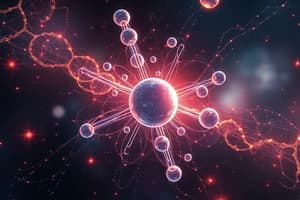Podcast
Questions and Answers
What is the atomic number of an element?
What is the atomic number of an element?
- The sum of protons and neutrons in the nucleus
- The smallest particle of matter
- The number of electrons revolving around the nucleus
- The number of protons present in the nucleus of its atoms (correct)
What is the mass number of an atom?
What is the mass number of an atom?
- The number of protons present in the nucleus
- The number of neutrons present in the nucleus
- The sum of number of protons and neutrons present in the nucleus (correct)
- The number of electrons revolving around the nucleus
What are nucleons?
What are nucleons?
- Particles found in the electron orbits
- Particles with a positive charge
- Particles with a negative charge
- Particles found in the nucleus of an atom, including protons and neutrons (correct)
What are isotopes?
What are isotopes?
What is meant by nuclide?
What is meant by nuclide?
Flashcards are hidden until you start studying
Study Notes
Atomic Structure
- Atomic number of an element is the number of protons present in the nucleus of an atom, which determines the identity of an element.
- Mass number of an atom is the total number of protons and neutrons present in the nucleus of an atom.
Nucleons and Nuclides
- Nucleons are the protons and neutrons present in the nucleus of an atom.
- Isotopes are atoms of the same element with the same atomic number (number of protons) but different mass numbers (different number of neutrons).
- A nuclide is a specific atom with a certain number of protons and neutrons in its nucleus, often represented by the symbol AX, where A is the mass number and X is the symbol of the element.
Studying That Suits You
Use AI to generate personalized quizzes and flashcards to suit your learning preferences.



